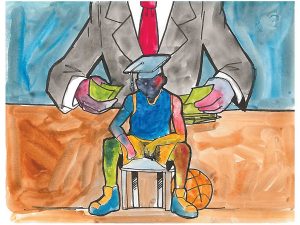
The question of whether student athletes ought to be paid (and if so, how much) is a continuous source of debate, one which the National Collegiate Athletic Association (NCAA) recently exacerbated (yet again) by its handling of a recent lawsuit regarding paying their athletes. Last year, Lawrence “Poppy” Livers, a former NCAA athlete, filed a lawsuit against the NCAA which argued that student athletes who receive scholarships also ought to be considered employees and receive payment.
Unsurprisingly, the NCAA motioned to dismiss the suit, but as noted by The Intercept, their argument for why the motion should be dismissed was based, in part, on court cases which were in turn informed by precedents set by Vanskike v. Peters. This was a 1992 court case in which Daniel Vanskike, a prisoner at Stateville Correctional Center in Illinois, argued for his right to receive minimum-wage pay for his labor as a prisoner. The court ruled against Vanskike, in part because the Thirteenth Amendment, although formally abolishing slavery in the U.S. when it was adopted in 1865, allows for “involuntary servitude … as a punishment whereof the party shall have been duly convicted.”
It seems that the NCAA is, perhaps without realizing it, using poor logic to conflate student athletes with prisoners performing involuntary servitude in order to get out of duly compensating said athletes for the billions of dollars in revenue that college sports generate for the NCAA (and all the other companies that profit from college sports) each year. The NCAA’s motion to dismiss Livers’ case demonstrates an utter lack of respect for the athletes whose efforts they continually profit from while giving little in return. Although one might argue that the voluntary nature of participating in college sports keeps athletes from being “employees” of their school, or that the scholarships that some receive are already adequate compensation, it has been clear for years that athletes are getting the short end of the stick in this relationship and ought to be better treated and compensated.
However, with paying student athletes comes the logistical problem of figuring out how much to pay them, and how. While it’s easy to point the finger at schools that make millions each year from college sports, it’s important to recognize that not every school makes such a vast profit from their athletics programs, making paying each athlete a financially tricky prospect. Perhaps student athletes could be allowed to earn money through endorsement deals, if the schools they play for cannot adequately foot the bill. This option was floated by NCAA president Mark Emmert to the Associated Press on Friday, March 3, and Emmert said he “would be surprised” if schools approved a model that requires them to pay athletes directly. However, this model threatens to only benefit the very top players, who would typically receive these endorsements at the professional level, and wouldn’t necessarily compensate all student athletes.
A more fair option is to pay the athletes through federal work-study programs, though this would possibly result in players not receiving nearly enough for what the NCAA makes from them, considering the limits on how many hours can be worked under work-study. This, unfortunately, may be one of the only reasonable options for the colleges to pay student athletes, considering the NCAA’s perpetual insistence on not recognizing their athletes as employees, despite the numerous court cases that have been brought to them asserting that they should be treated as such. Then, of course, there’s their lip-service to the value of “amateurism” in college sports, which sounds like little more than a lofty excuse for stringing student athletes along with measly scholarships (very few of which are full ride or even substantial) that don’t even come close to the over $1 billion in ad revenue brought in by the men’s basketball tournament broadcasts, shared between CBS and Turner. This is not to mention the $8.8 billion deal these companies just signed with the NCAA, which is an extension to their 14-year, $10.8 billion deal that runs through 2024.
However, even if student athletes have to be under-compensated through work study, it is more than obvious that they deserve some form of compensation, and certainly more than what they have received so far. Although what they do may not appear to be “work” in the traditional sense, student athletes often have to spend time comparable to an average work week on their respective sports. In the NCAA’s very own “2015 GOALS Study of the Student-Athlete Experience,” Division I, II and III student athletes self-reported spending between 27 and 42 median hours per week on “Athletic Activities In-Season” in 2015. Taking this and the profit that the NCAA makes from these students, from broadcasting deals to ticket sales at games to even using players’ likenesses in video games (which the players weren’t even paid for until EA Sports took issue with not paying them), it’s increasingly difficult to see the validity in the argument that what student athletes do isn’t work and doesn’t deserve pay.
The NCAA’s attempt to simply dismiss Livers’ case comes as no surprise, and serves as a reminder that the current relationship between the NCAA and its student athletes puts the profits before the students. It is unacceptable that the amount of time and effort that student athletes spend on their sports is not properly compensated as any other job would be. Perhaps the NCAA will, with enough pressure, recognize this and improve their treatment of their athletes, but the far more likely outcome is that, for now, federal work study will have to do to make sure the student athletes receive at least some of the payment they’ve earned.








